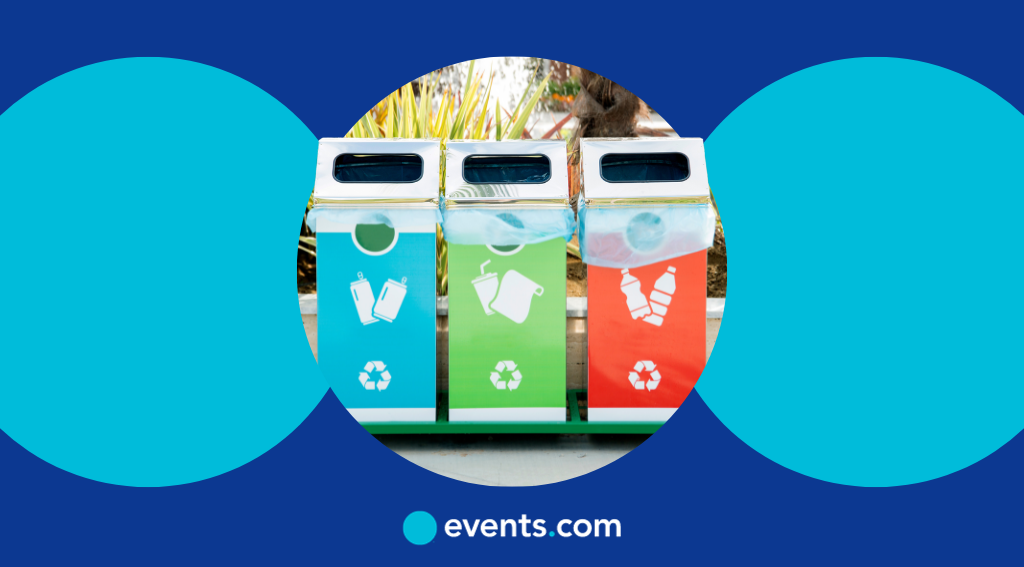In a time when people are increasingly more environmentally conscious, planning sustainable events has never been more important. Sustainable events, whether they’re festivals, races, conferences, or festivals, have the potential to leave lasting positive impacts on the planet and local communities. These events can help you educate people about sustainability, find like-minded partners, and even increase brand awareness. Sustainable events look different each time, so in this article, we will explore 10 strategies to plan and execute sustainable events successfully.
What Does a Sustainable Event Entail?
A sustainable event will typically minimize negative impacts on the environment and also leave a healthy, positive impact on the economy in which the event was hosted. Sustainable event planners may do this by incorporating sustainable practices like reducing greenhouse gas emissions, reducing unnecessary waste, and sourcing sustainable event materials and catering. Maintaining an inclusive environment also plays an important part in sustainable event management. Ultimately, a great sustainable event strikes a balance between enjoyment and responsibility, leaving a positive legacy for both the environment and the community.
10 Sustainable Event Ideas and How To Implement Them
Discovering ways to host environmentally sustainable events that leave a lasting positive impact is not only an important responsibility but also an exciting opportunity. Keep reading to learn 10 sustainable event practices to effectively plan sustainable events.
1. Find Sustainable Event Venues
An important step in planning a successful sustainable event is to carefully select a venue because your venue can significantly influence your event’s environmental impact. For example, opting for a venue that’s close to your target audience can reduce your carbon emissions and make the experience more enjoyable for your guests. Additionally, some venues have more natural features and open spaces than others, which can help you eliminate the need for artificial lighting and reduce your energy consumption. You could also choose more nontraditional venues, such as galleries, retail stores, or restaurants, that have a LEED (Leadership in Energy and Environmental Design) certification, which is a certification that awards buildings that have met certain standards for things like energy efficiency and water conservation.
2. Consider Your Attendees’ Form of Transportation
Another effective and often underestimated strategy for planning successful sustainable events is to consider your attendees’ form of transportation. By encouraging and facilitating more environmentally conscious transportation choices, you can significantly reduce the environmental impact of their gatherings. You could do this by providing clear information on public transportation options, arranging shuttle services, or incentivizing carpooling. Additionally, you can promote bicycle-friendly facilities to encourage attendees to choose sustainable commuting methods.
People often don’t choose the sustainable option because it’s more complicated. However, if you make it easy for your guests, you can create a great experience while keeping your event as sustainable as possible.
3. Hire Locally Sourced Catering Services
Some event planners choose to hire locally sourced catering services to create an amazing, sustainable event. This approach can help to reduce the carbon footprint associated with transporting food over long distances. It also fosters a stronger connection between the event and its community, supporting local businesses and promoting a sense of local pride. Locally sourced caterers also tend to have fresher and more nutritious food, so your event attendees will greatly enjoy the food provided to them. By choosing local catering, you not only prioritize sustainability in events but also create a unique experience that highlights the flavors and culture of your event’s location rather than feeding your guests the same food they can have anywhere else.
4. Avoid Single-Use Plastic
A highly impactful and fairly straightforward strategy for planning successful sustainable events is to avoid single-use plastic. The regular use of single-use plastics, such as utensils, cups, and straws, at events contributes significantly to environmental pollution. You can combat this at your events by opting for eco-friendly alternatives like biodegradable or reusable items made from materials such as bamboo or paper. This not only reduces your environmental impact but also sets a positive example for attendees and other event planners. This small yet impactful change can go a long way in creating a more sustainable event.
5. Evaluate Doing Hybrid or Virtual Events
Another way event planners have been creating more sustainable events that people love is by transitioning to a hybrid event or virtual event. Hybrid and virtual events significantly reduce the environmental impact associated with in-person events since attendees no longer need to travel long distances or create a lot of waste. They also can make your event more accessible to a global audience, promoting inclusivity. All the socializing and networking can occur online with little environmental impact. You can make these events incredibly enjoyable by creating games, conducting forums or Q&As, or creating virtual photo booths. So, the next time you have to plan an event, think about whether it makes sense to do it virtually or using the hybrid model, as you can cut costs and improve your event sustainability.
6. Get Your Recycling Game On
One of the easiest ways to create a more sustainable event is by getting your recycling game on. You can start this by using as much recyclable material as possible at your event. Then, you can provide ample recycling bins so it’s easy for your event’s attendees to make the sustainable choice. This simple step is important because many people recycle in their own homes, so if your event doesn’t demonstrate this simple commitment to sustainability, this may be off-putting for some guests. Recycling is not only an easy way to make your event more sustainable, but it’s also a great way to empower your guests to make sustainable choices.
7. Provide Specific Containers for Segregated Waste Management
Another very effective strategy for planning a sustainable event is providing specific containers for segregated waste management. You can set up separate bins for recyclables, compostables, and non-recyclable waste, each clearly labeled and strategically placed throughout the event venue. By making it easy and convenient for attendees to dispose of their waste responsibly, you can reduce the environmental impact of your event tremendously.
It doesn’t stop there, however, as it’s important to make sure that the collected waste is sent to the appropriate facilities. You can even partner with local recycling facilities or waste management companies to ensure that collected materials are processed responsibly. This strategy not only minimizes the event’s carbon footprint by diverting waste from landfills but also sends a powerful message about the importance of responsible waste management, inspiring attendees to adopt these practices in their daily lives.
8. Include Eco-Friendly Swag
Instead of handing out gift bags of traditional promotional items that often just end up in the trash, think about handing out eco-friendly products at your next events. This might include reusable water bottles, tote bags made from recycled materials, or sustainable notebooks. This eco-friendly swag reduces the production of unsustainable items and can serve as lasting memories of your event. This makes your event stand out in their minds and also reinforces the message of environmental responsibility. This is a win-win situation!
9. Forgo Paper in Any Form
Another increasingly popular strategy to make your event more sustainable is to get rid of paper in any form at your events. Rather than using paper tickets, menus, or a sustainable events guide, you can have guests access these items digitally using QR codes. This not only reduces paper consumption but can also help you cut costs since these can be quite expensive, especially as your event grows in size. Attendees are increasingly receptive to paperless experiences, and this strategy aligns with the global shift towards eco-consciousness. It’s a great way to create a greener and more successful event.
10. Reduce Your Event’s Carbon Footprint With End-to-End Platforms
Another way to reduce your event’s carbon footprint is to use end-to-end platforms throughout your green event planning processes. Event management platforms can help you create digital tickets for your events, track attendees’ experiences, and evaluate event data, such as attendance rates, to ensure each event gets better and better. Instead of wasting paper on tickets or feedback forms, you can do these digitally in one localized hub instead of having everything in different places. This will not only help you reduce waste, but it can also help you make the event management process far less chaotic and far more organized.
Discover Seamless Sustainable Event Planning With Events.com
Seamless and sustainable event planning is now more attainable than ever with Events.com. This innovative platform offers event organizers a comprehensive toolkit to integrate eco-friendly practices effortlessly. Events.com minimizes waste and reduces the environmental impact of events by digitizing ticketing and promotional materials like landing pages. Additionally, you can use Events.com to access custom reports and insights, enabling data-driven decisions to reach your sustainability goals. With Events.com, you can create successful, sustainable events that people want to attend time and time again. Start using Events.com today to level up your events.







